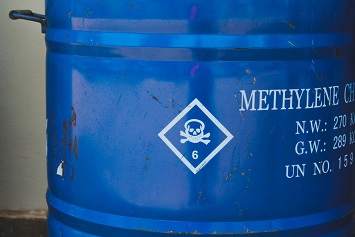The EPA issued its final risk evaluation for methylene chloride under the Toxic Substances Control Act (TSCA) on June 24, 2020. The EPA findings indicate that methylene chloride (also known as dichloromethane and methylene dichloride) poses threats to human health and safety in 47 out of the 53 types of uses reviewed, including threats to both consumers and workers exposed to commercial uses of the chemical.
The types of uses reviewed included consumer adhesives, automobile care products, cleaners, degreasers, sealants, and commercial paint and coating removal.
Common consumer uses include “aerosol degreasers/cleaners, adhesives/sealants, paint brush cleaners, lubricants, arts and crafts glue, and automobile care products like air conditioner fluids,” according to the EPA.
Methylene chloride is used commercially for “solvents for vapor degreasing, aerosol spray cleaners, adhesives, paint/coating remover, and automotive care products,” the EPA says.
No unreasonable risks were found to the environment after assessing the chemical’s impact on aquatic life and plants through studies of sediment and surface water contaminants.
The EPA’s final evaluation determined that risks to both consumers and workers come from “inhalation and dermal (through the skin) exposure.”
Methylene chloride smells slightly sweet and is a colorless liquid. It was banned for use in consumer paint thinners by the EPA on November 22, 2019. In addition to the uses described above, it is also used as an extractant solvent in both medical applications and food and beverage manufacturing. For example, it can be used to extract caffeine from coffee beans.
“OSHA’s Methylene Chloride Standard sets a permissible exposure limit of 25 parts of methylene chloride per million parts of air over an eight-hour period,” according to ChemicalSafetyFacts.org. “When methylene chloride is used in food and beverage processing, the U.S. Food and Drug Administration (FDA) sets limits for the amount of the chemical that can remain as a residue in food products.”
Occupational Safety and Health Administration (OSHA) guidelines require employers to maintain proper ventilation and provide respirators and other safety gear to employees working with methylene chloride.
In its proposed rulemaking document, published by the EPA on March 27, 2019, the Agency suggested the future establishment of a federally enforceable training, certification, and limited-access program for methylene chloride that would allow “access to paint and coating removal products containing methylene chloride only to commercial users who are certified as properly trained to engage in use practices that do not present unreasonable risks,” according to EPA documents published in the Federal Register.
The proposed rule received 37,081 comments before the comment period closed on May 28, 2019.
Risk management is the next step in the TSCA required process.
The Agency will “propose and take public comments on actions to address the unreasonable risks identified in the risk evaluation.” The act requires the EPA to publish proposed methods to deal with the identified risks, take public comments within 1 year, and “finalize those actions within two years of completing the final risk evaluation.”
According to the Agency, those proposed regulations “could include prohibitions or requirements that limit the manufacture, processing, distribution in commerce, use, or disposal of this chemical substance, as applicable.”

